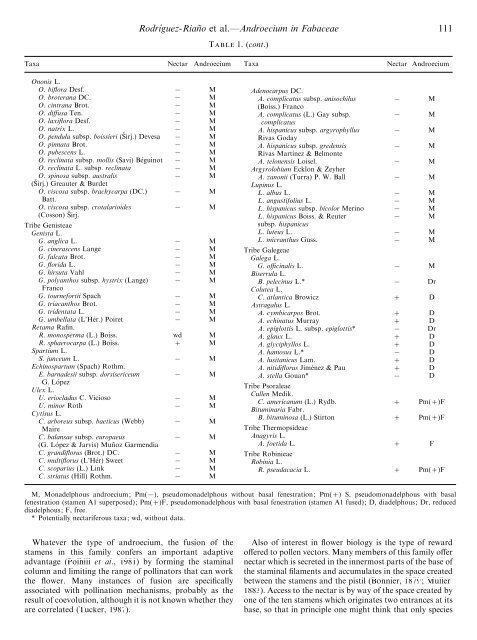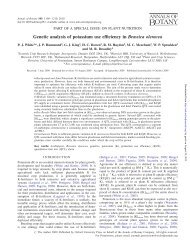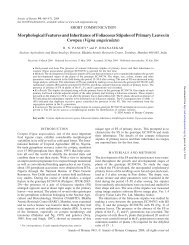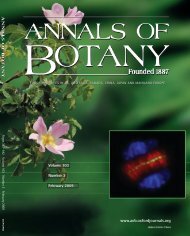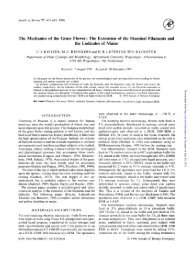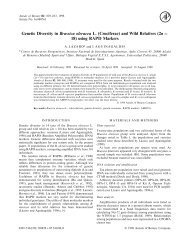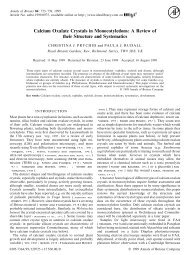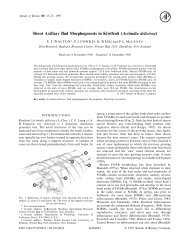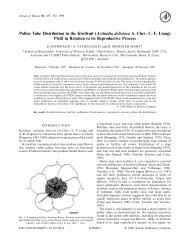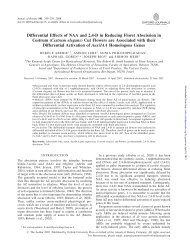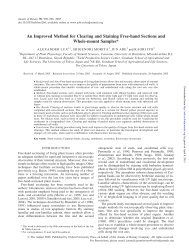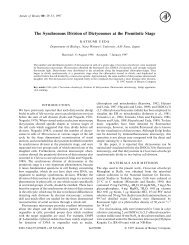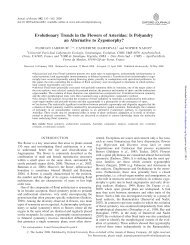Types of Androecium in the Fabaceae of SW ... - Annals of Botany
Types of Androecium in the Fabaceae of SW ... - Annals of Botany
Types of Androecium in the Fabaceae of SW ... - Annals of Botany
Create successful ePaper yourself
Turn your PDF publications into a flip-book with our unique Google optimized e-Paper software.
Rodrıguez-Rian o et al.—<strong>Androecium</strong> <strong>in</strong> <strong>Fabaceae</strong> 111<br />
Table 1. (cont.)<br />
Taxa Nectar <strong>Androecium</strong> Taxa Nectar <strong>Androecium</strong><br />
Ononis L.<br />
O. biflora Desf. M<br />
O. broterana DC. M<br />
O. c<strong>in</strong>trana Brot. M<br />
O. diffusa Ten. M<br />
O. laxiflora Desf. M<br />
O. natrix L.<br />
O. pendula subsp. boissieri (S irj.) Devesa<br />
<br />
<br />
M<br />
M<br />
O. p<strong>in</strong>nata Brot. M<br />
O. pubescens L. M<br />
O. recl<strong>in</strong>ata subsp. mollis (Savi) Be gu<strong>in</strong>ot M<br />
O. recl<strong>in</strong>ata L. subsp. recl<strong>in</strong>ata M<br />
O. sp<strong>in</strong>osa subsp. australis<br />
(S irj.) Greauter & Burdet<br />
M<br />
O. iscosa subsp. brachycarpa (DC.) M<br />
Batt.<br />
O. iscosa subsp. crotalarioides<br />
(Cosson) S irj.<br />
Tribe Genisteae<br />
Genista L.<br />
M<br />
G. anglica L. M<br />
G. c<strong>in</strong>erascens Lange M<br />
G. falcata Brot. M<br />
G. florida L. M<br />
G. hirsuta Vahl M<br />
G. polyanthos subsp. hystrix (Lange) M<br />
Franco<br />
G. tournefortii Spach M<br />
G. triacanthos Brot. M<br />
G. tridentata L. M<br />
G. umbellata (L’He r.) Poiret<br />
Retama Raf<strong>in</strong>.<br />
M<br />
R. monosperma (L.) Boiss. wd M<br />
R. sphaerocarpa (L.) Boiss.<br />
Spartium L.<br />
M<br />
S. junceum L.<br />
Ech<strong>in</strong>ospartum (Spach) Rothm.<br />
M<br />
E. barnadesii subsp. dorsisericeum M<br />
G. Lo pez<br />
Ulex L.<br />
U. eriocladus C. Vicioso M<br />
U. m<strong>in</strong>or Roth<br />
Cytisus L.<br />
M<br />
C. arboreus subsp. baeticus (Webb) M<br />
Maire<br />
C. balansae subsp. europaeus M<br />
(G. Lo pez & Jarvis) Mun oz Garmendia<br />
C. grandiflorus (Brot.) DC. M<br />
C. multiflorus (L’He r) Sweet M<br />
C. scoparius (L.) L<strong>in</strong>k M<br />
C. striatus (Hill) Rothm. M<br />
M, Monadelphous androecium; Pm(), pseudomonadelphous without basal fenestration; Pm() S, pseudomonadelphous with basal<br />
fenestration (stamen A1 superposed); Pm()F, pseudomonadelphous with basal fenestration (stamen A1 fused); D, diadelphous; Dr, reduced<br />
diadelphous; F, free.<br />
* Potentially nectariferous taxa; wd, without data.<br />
Whatever <strong>the</strong> type <strong>of</strong> androecium, <strong>the</strong> fusion <strong>of</strong> <strong>the</strong><br />
stamens <strong>in</strong> this family confers an important adaptive<br />
advantage (Polhill et al., 1981) by form<strong>in</strong>g <strong>the</strong> stam<strong>in</strong>al<br />
column and limit<strong>in</strong>g <strong>the</strong> range <strong>of</strong> poll<strong>in</strong>ators that can work<br />
<strong>the</strong> flower. Many <strong>in</strong>stances <strong>of</strong> fusion are specifically<br />
associated with poll<strong>in</strong>ation mechanisms, probably as <strong>the</strong><br />
result <strong>of</strong> coevolution, although it is not known whe<strong>the</strong>r <strong>the</strong>y<br />
are correlated (Tucker, 1987).<br />
Adenocarpus DC.<br />
A. complicatus subsp. anisochilus<br />
(Boiss.) Franco<br />
M<br />
A. complicatus (L.) Gay subsp.<br />
M<br />
complicatus<br />
A. hispanicus subsp. argyrophyllus<br />
Rivas Goday<br />
M<br />
A. hispanicus subsp. gredensis<br />
Rivas Martınez & Belmonte<br />
M<br />
A. telonensis Loisel.<br />
Argyrolobium Ecklon & Zeyher<br />
M<br />
A. zanonii (Turra) P. W. Ball<br />
Lup<strong>in</strong>us L.<br />
M<br />
L. albus L. M<br />
L. angustifolius L. M<br />
L. hispanicus subsp. bicolor Mer<strong>in</strong>o M<br />
L. hispanicus Boiss. & Reuter<br />
subsp. hispanicus<br />
M<br />
L. luteus L. M<br />
L. micranthus Guss.<br />
Tribe Galegeae<br />
Galega L.<br />
M<br />
G. <strong>of</strong>fic<strong>in</strong>alis L.<br />
Biserrula L.<br />
M<br />
B. pelec<strong>in</strong>us L.*<br />
Colutea L.<br />
Dr<br />
C. atlantica Browicz<br />
Astragalus L.<br />
D<br />
A. cymbicarpos Brot. D<br />
A. ech<strong>in</strong>atus Murray D<br />
A. epiglottis L. subsp. epiglottis* Dr<br />
A. glaux L. D<br />
A. glyciphyllos L. D<br />
A. hamosus L.* D<br />
A. lusitanicus Lam. D<br />
A. nitidiflorus Jime nez & Pau D<br />
A. stella Gouan*<br />
Tribe Psoraleae<br />
Cullen Medik.<br />
D<br />
C. americanum (L.) Rydb.<br />
Bitum<strong>in</strong>aria Fabr.<br />
Pm()F<br />
B. bitum<strong>in</strong>osa (L.) Stirton<br />
Tribe Thermopsideae<br />
Anagyris L.<br />
Pm()F<br />
A. foetida L.<br />
Tribe Rob<strong>in</strong>ieae<br />
Rob<strong>in</strong>ia L.<br />
F<br />
R. pseudacacia L. Pm()F<br />
Also <strong>of</strong> <strong>in</strong>terest <strong>in</strong> flower biology is <strong>the</strong> type <strong>of</strong> reward<br />
<strong>of</strong>fered to pollen vectors. Many members <strong>of</strong> this family <strong>of</strong>fer<br />
nectar which is secreted <strong>in</strong> <strong>the</strong> <strong>in</strong>nermost parts <strong>of</strong> <strong>the</strong> base <strong>of</strong><br />
<strong>the</strong> stam<strong>in</strong>al filaments and accumulates <strong>in</strong> <strong>the</strong> space created<br />
between <strong>the</strong> stamens and <strong>the</strong> pistil (Bonnier, 1879; Mu ller,<br />
1883). Access to <strong>the</strong> nectar is by way <strong>of</strong> <strong>the</strong> space created by<br />
one <strong>of</strong> <strong>the</strong> ten stamens which orig<strong>in</strong>ates two entrances at its<br />
base, so that <strong>in</strong> pr<strong>in</strong>ciple one might th<strong>in</strong>k that only species


